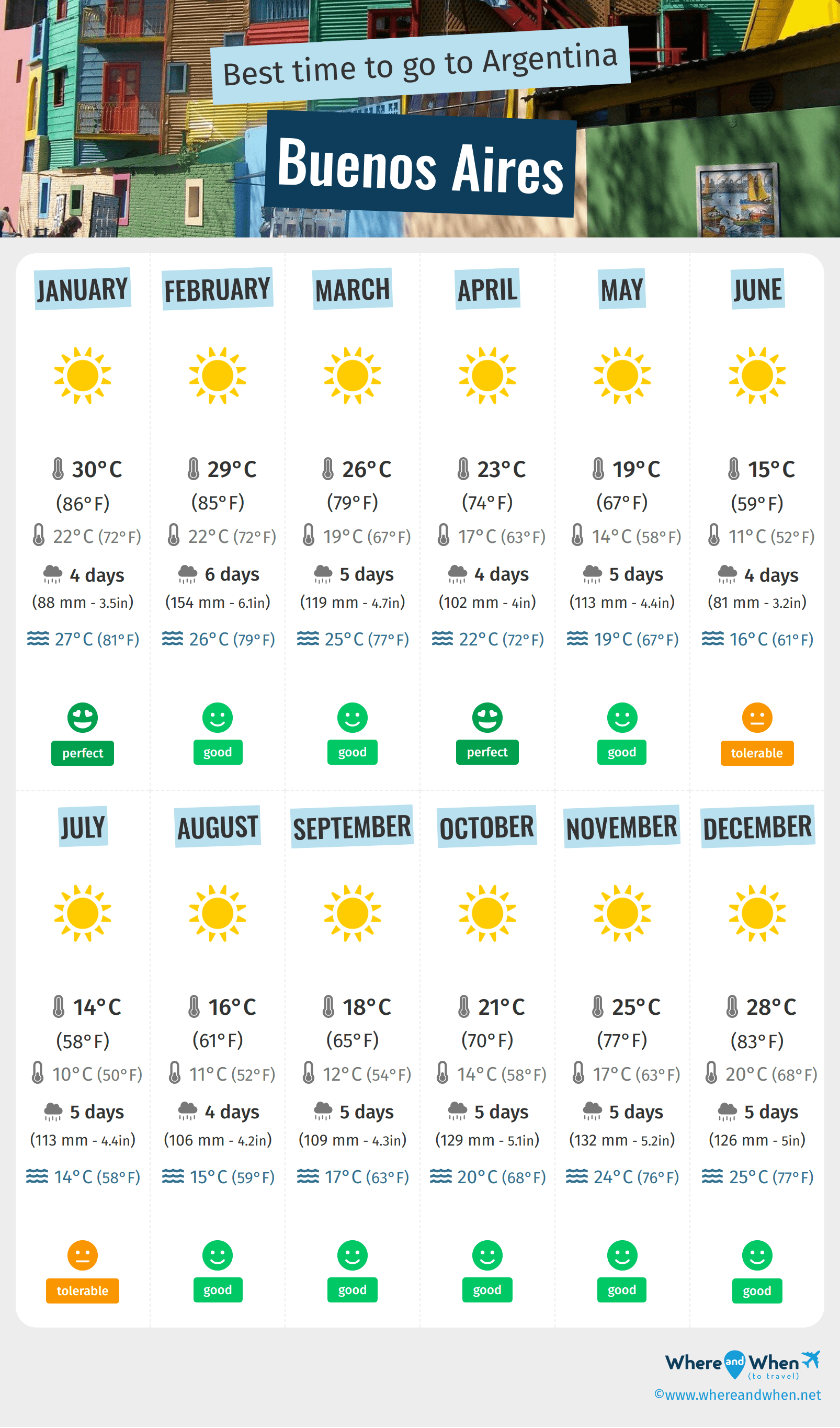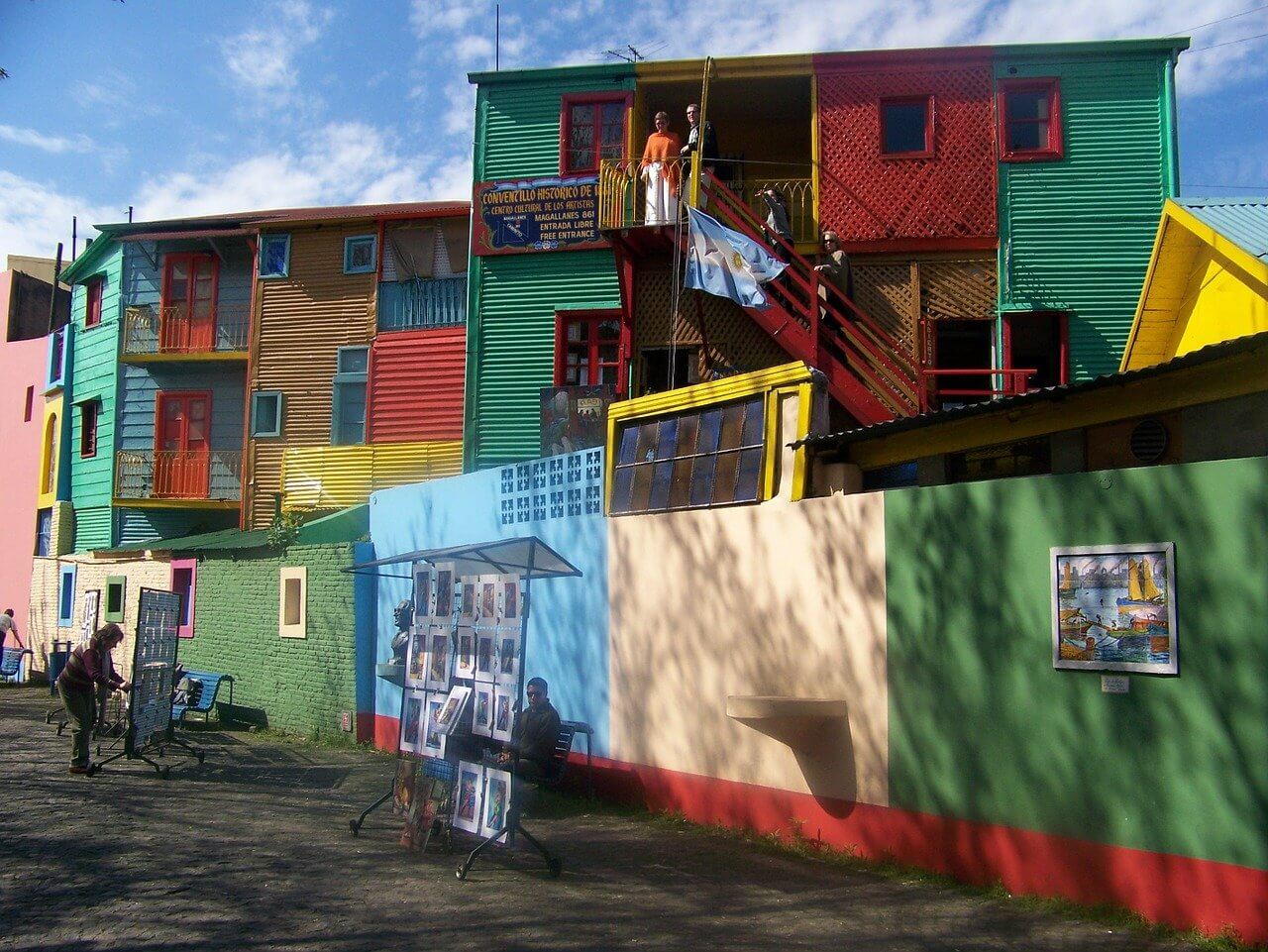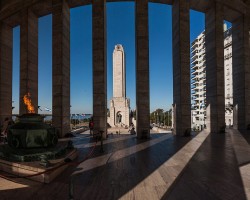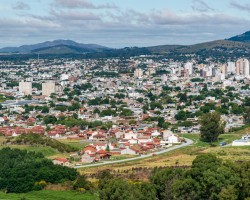Best time to go to Buenos Aires Average weather of Buenos Aires, Argentina
When is the best time to go to Buenos Aires?
Capital and the most important city of Argentina, Buenos Aires is a city of great cultural richness that can be visited throughout the year. In fact, it welcomes thousands of visitors annually ready to discover its numerous museums. However, it should be noted that the best time to visit Buenos Aires is from January to May, and then from August to December.
Indeed, it is during this period that the weather will be the most pleasant. Between December and March, it is summer in Argentina! You can expect many sunny days and warm temperatures, between 22 and 30°C (86°F) .
Moreover, in December, you can take advantage of the beautiful season to attend the Tango Day in Buenos Aires, as Argentina is the birthplace of this dance.
However, summer also coincides with the high tourist season. Prices are higher and there is a large influx of tourists.
Therefore, if you are looking for a quieter atmosphere and a lower travel budget, you can opt for the low season. For example, you can plan a trip during the months of March, April, and May. The weather remains very pleasant during this period.
Finally, even though July is the coldest month of the year, it can still be interesting to visit Buenos Aires during this time. Indeed, on the 9th of this month, Independence Day is celebrated. You will find a series of colorful events and festivities. Traveling on this date will be a great way to immerse yourself in Argentine culture.
Moreover, despite slightly cooler temperatures with temperatures below 15°C (59°F) , the weather remains quite decent during winter in Buenos Aires.
So, when is the best time to go to Buenos Aires? Here's some more information to help you in your decision:
- The best months for good weather in Buenos Aires are January, February, March, April, May, August, September, October, November and December
- On average, the warmest months are January, February and December
- July is the coldest month of the year
- The rainiest months are February, October, November and December
- The best months for swimming are January, February, March and December
Annual weather in Buenos Aires

Weather details in Buenos Aires month by month
Weather and climate in Buenos Aires
The climate varies greatly in Argentina from one city to another. For example, in the capital, Buenos Aires, it is of humid subtropical type, while a desert climate is found in Patagonia.
The weather in Buenos Aires has relatively distinct seasons. Furthermore, the climate there is influenced by several types of winds that can abruptly change temperatures and weather. These include:
- El pampero: a cold and dry wind from the southwest that blows mainly in summer. It causes violent storms and a drop in temperature.
- El sudestada: a cool and humid wind from the southeast, which often brings light rain for a few days. After its passage, cold temperatures are felt.
- El zonda: this hot and dry wind blows more between the months of May and October. It brings sudden heat, even in the heart of winter.
Let's take a closer look at the climate in Buenos Aires throughout the seasons.
Climate in Buenos Aires in winter
Unlike France, winter in Buenos Aires extends from June to September. While winters are long in Ushuaia, the southernmost city in the country, they are relatively short in the Argentine capital. Moreover, they are also particularly mild, with temperatures often ranging between 10 and 15°C (59°F) . Thus, even during the coldest days, the mercury rarely drops below 5°C (41°F) in Buenos Aires.
Additionally, the weather is relatively dry in winter. It is rare to have lasting precipitation during this time of year. The days are often sunny between June and September. However, the sky is often cloudy in winter, and fog may be present.
Finally, snow is rare in Buenos Aires in winter. In recent years, there have been a few snowflakes in 1918 and 2007 only...
Climate in Buenos Aires in summer
Summer in Buenos Aires extends from December to March, which corresponds to winter in Europe.
As the capital of Argentina is subject to a humid subtropical climate, summer can be unbearably hot at times.
Indeed, although average temperatures are not very high, sudden heat waves can occur. Moreover, the stifling heat is amplified by the high humidity levels, reminiscent of the climate in cities in neighboring southern Brazil.
Thus, the mercury averages between 22 and 30°C (86°F) in summer in Buenos Aires, but on some days, the heat can rise to around 37°C (99°F) .
Furthermore, although there is significant sunshine during the summer in Argentina, it is also a rainy season.
Therefore, you may experience some showers and thunderstorms, especially in the late afternoon. However, as they quickly subside, the precipitation should not disrupt your stay.
Finally, the sea is rarely very warm in Buenos Aires, but it will be warm enough if you plan to swim at this time of year. In fact, the sea temperature is around 22°C between January and March.
Climate in Buenos Aires in spring and autumn
As a reminder, the seasons in Argentina are reversed compared to France. Thus, spring extends from September to mid-December, and autumn extends from March to June.
Given its subtropical climate, the city of Buenos Aires does not really experience distinct spring and autumn seasons. Indeed, the difference in climate is not as pronounced as between winter and summer.
Nevertheless, these two seasons are relatively humid periods with mild to warm temperatures, even hot just before summer. There may be precipitation, which is often heavier in autumn (between March and June).
Sometimes, violent rains can suddenly fall on the city, especially in April and May.
However, it can be noted that these two seasons in Buenos Aires are relatively pleasant. There are many sunny days and mild temperatures.
Generally, the mercury hovers around 15 to 20°C (68°F) during these seasons. In November, temperatures rise a bit, reaching up to 25°C (77°F) . Additionally, in April, the heat lingers with an average of around 22°C (72°F) .
However, you won't be able to swim if you travel to Buenos Aires in autumn and spring. The sea temperature is below 20°C (68°F) .

Charts: temperature and rainfall in Buenos Aires
In the charts below, you can see the following seasonal norms for the city of Buenos Aires: the minimum and maximum outdoor temperature, the risk and amount of monthly rainfall, daily average sunshine, sea temperature, and relative humidity for each month of the year.
Outside temperature
Precipitation (rainfall)
Daily sunshine hours
Sea temperature
Humidity
Peak visitor numbers and tourist seasons in Buenos Aires
Find out when Buenos Aires has its high tourist season (the period when the influx of tourists is highest) and off-peak tourist season using our data and figures.
Tourist seasons in Buenos Aires
- Very low season in Buenos Aires
The months with the lowest number of tourists are: February, March and June. - Low season in Buenos Aires
The months with low numbers of tourists are: January, April, May, August and September. - High season in Buenos Aires
The number of visitors to Buenos Aires is high in: July and October. - Peak season in Buenos Aires
The largest number of tourists visiting Buenos Aires is during: November and December.
Figure: Visitor index for Buenos Aires month by month
Best time for low prices in Buenos Aires
Average prices of hotels in Buenos Aires month by month
Generally, June is the month with the lowest hotel prices in Buenos Aires. So this is a great time to save on your holiday! In contrast, November is statistically the most expensive month of the year for hotels.
Find the best price for your hotel room
Average price for flights to Buenos Aires
A return flight between London and Buenos Aires is generally cheaper if you go in march ($ 1052 on average): this is the best time for travellers on a tight budget. In contrast, you may end up paying $ 374 more for your airline ticket to Buenos Aires if you go in august.
Find the best price for your flight
Average price of hiring a car in Buenos Aires
On average, it costs $ 91 per day to hire a car in Buenos Aires. This price varies by $ 29 depending on the month. In may, hiring a car costs an average of $ 81 per 24 hours, so this is the best time to save money! In contrast, the average price in december is $ 109.
Other cities and places near Buenos Aires
 Buenos Aires
Buenos Aires
 other locations
other locations




